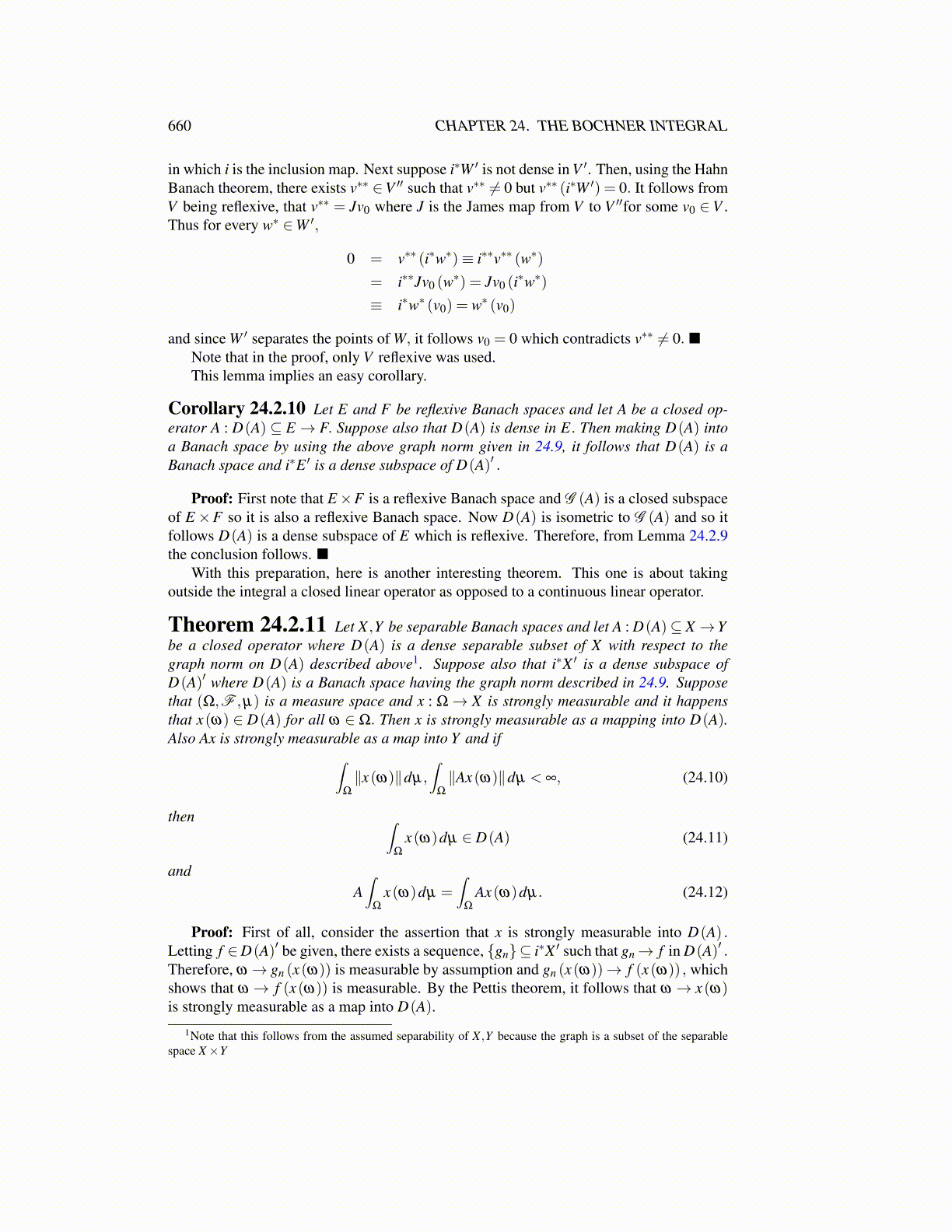
660 CHAPTER 24. THE BOCHNER INTEGRAL
in which i is the inclusion map. Next suppose i∗W ′ is not dense in V ′. Then, using the HahnBanach theorem, there exists v∗∗ ∈V ′′ such that v∗∗ ̸= 0 but v∗∗ (i∗W ′) = 0. It follows fromV being reflexive, that v∗∗ = Jv0 where J is the James map from V to V ′′for some v0 ∈ V .Thus for every w∗ ∈W ′,
0 = v∗∗ (i∗w∗)≡ i∗∗v∗∗ (w∗)
= i∗∗Jv0 (w∗) = Jv0 (i∗w∗)
≡ i∗w∗ (v0) = w∗ (v0)
and since W ′ separates the points of W, it follows v0 = 0 which contradicts v∗∗ ̸= 0. ■Note that in the proof, only V reflexive was used.This lemma implies an easy corollary.
Corollary 24.2.10 Let E and F be reflexive Banach spaces and let A be a closed op-erator A : D(A) ⊆ E → F. Suppose also that D(A) is dense in E. Then making D(A) intoa Banach space by using the above graph norm given in 24.9, it follows that D(A) is aBanach space and i∗E ′ is a dense subspace of D(A)′ .
Proof: First note that E×F is a reflexive Banach space and G (A) is a closed subspaceof E×F so it is also a reflexive Banach space. Now D(A) is isometric to G (A) and so itfollows D(A) is a dense subspace of E which is reflexive. Therefore, from Lemma 24.2.9the conclusion follows. ■
With this preparation, here is another interesting theorem. This one is about takingoutside the integral a closed linear operator as opposed to a continuous linear operator.
Theorem 24.2.11 Let X ,Y be separable Banach spaces and let A : D(A)⊆ X→Ybe a closed operator where D(A) is a dense separable subset of X with respect to thegraph norm on D(A) described above1. Suppose also that i∗X ′ is a dense subspace ofD(A)′ where D(A) is a Banach space having the graph norm described in 24.9. Supposethat (Ω,F ,µ) is a measure space and x : Ω→ X is strongly measurable and it happensthat x(ω) ∈ D(A) for all ω ∈ Ω. Then x is strongly measurable as a mapping into D(A).Also Ax is strongly measurable as a map into Y and if∫
Ω
∥x(ω)∥dµ,∫
Ω
∥Ax(ω)∥dµ < ∞, (24.10)
then ∫Ω
x(ω)dµ ∈ D(A) (24.11)
andA∫
Ω
x(ω)dµ =∫
Ω
Ax(ω)dµ. (24.12)
Proof: First of all, consider the assertion that x is strongly measurable into D(A) .Letting f ∈D(A)′ be given, there exists a sequence, {gn}⊆ i∗X ′ such that gn→ f in D(A)′ .Therefore, ω→ gn (x(ω)) is measurable by assumption and gn (x(ω))→ f (x(ω)) , whichshows that ω → f (x(ω)) is measurable. By the Pettis theorem, it follows that ω → x(ω)is strongly measurable as a map into D(A).
1Note that this follows from the assumed separability of X ,Y because the graph is a subset of the separablespace X×Y